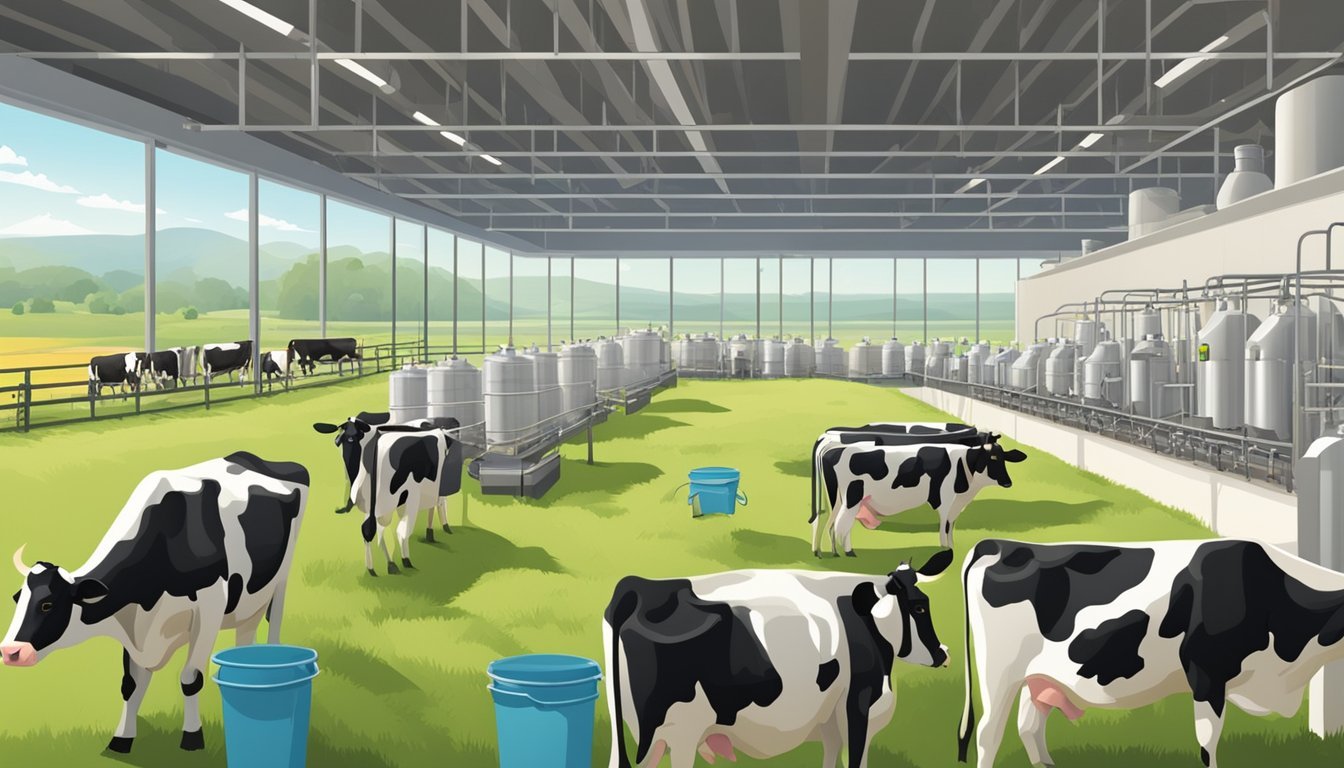The Complete Guide to Setting Up a Raw Milk Co-op
Essential Steps for Success
A raw milk co-op serves as a communal bridge between dairy farmers and consumers who prefer milk in its most natural state. This cooperative model offers members access to raw milk that hasn't been processed through pasteurization or homogenization, allowing them to enjoy the taste and purported nutritional benefits associated with unprocessed milk. Establishing such a co-op involves a clear understanding of local regulations, since the sale of raw milk is governed by specific laws that vary from place to place.
Efficient operation of a raw milk co-op relies on a structured system that handles the sourcing, storage, and distribution of milk with rigorous safety standards in place. Members typically engage in duties ranging from coordinating with farmers to manage the supply to ensuring the correct handling and refrigeration of the milk to maintain its quality and safety. This cooperative effort is crucial to balance both the availability of raw milk to consumers and to support the livelihood of local dairy farmers.
Transparency is also a key element in a successful raw milk co-op, with members often providing clear communication channels about the origins of the milk, the conditions under which the cows are raised, and the health and hygiene standards observed during milking and bottling. Trust in the product is paramount, as consumers of raw milk place significant value on the authenticity and farming practices behind the product they are purchasing. Therefore, education about the benefits and risks associated with raw milk consumption forms an essential component of the co-op's mission.
"The Complete Guide to Setting Up a Raw Milk Co-op" is an essential resource for anyone embarking on their raw milk journey. This comprehensive guide covers everything you need to know about the full-fat raw milk benefits and how to establish a successful co-op to share this nutritious product with your community.
The book delves into the nutritional deficiencies that can be addressed by consuming raw milk, highlighting its rich content of essential vitamins, minerals, and beneficial bacteria. It also dispels common raw milk safety myths, providing evidence-based information to help readers make informed decisions about their dairy choices.
Furthermore, "The Complete Guide to Setting Up a Raw Milk Co-op" introduces the concept of raw milk tourism, showcasing the potential for raw milk enthusiasts to visit farms and learn about the production process firsthand. The guide also explores the idea of introducing raw milk diet as a way to harness the health benefits of this natural, unprocessed food.
Overall, this guide is a valuable tool for those passionate about raw milk, offering practical advice and insights to support the establishment of a thriving co-op and the promotion of raw milk's numerous advantages.
Benefits of Raw Milk
Raw milk boasts a range of benefits stemming from its natural composition. It is a source of various nutrients that are essential for the human body. These benefits are maximized when the milk comes from grass-fed cows, known for producing milk with higher levels of beneficial compounds like butterfat and omega-3 fatty acids.
Nutritional Advantages
Raw milk is a complete food, containing:
Proteins: Vital for muscle repair and immune function, they're present in easily digestible form.
Vitamins: Particularly rich in fat-soluble vitamins A, D, and E, as well as water-soluble vitamins B and C, raw milk serves as an excellent source of these essential nutrients.
Butterfat: It contains butterfat, which not only contributes to its rich taste but also carries vitamins A and D as well as essential fatty acids.
The nutritional content is believed to be more bioavailable before pasteurization. When cows are grass-fed, their milk is found to have an improved nutrient profile, including an increase in omega-3 fatty acids, which are important for cardiovascular health and cognitive function.
Health Benefits
Individuals consuming raw milk have reported several health benefits:
Digestive Health: Some enthusiasts claim that the enzymes found in raw milk can aid in digestion, potentially helping those with lactose intolerance.
Immune System: Raw milk is thought to contain beneficial bacteria that can help strengthen the immune system, although this area requires more research for conclusive evidence.
It should be noted that while these benefits are reported by some, raw milk also carries a risk of foodborne illness and should be consumed with caution.
Understanding Raw Milk Safety
The safety of raw milk hinges on strict adherence to sanitation, disease control, and understanding the risks of unpasteurized dairy products. This section will navigate through the complexities of raw milk safety, touching on contamination, the pasteurization debate, and regulatory standards.
Dangers of Contamination
Raw milk can harbor dangerous pathogens such as Salmonella spp. and pathogenic E. coli, both of which are capable of causing severe illnesses. While Salmonella spp. have been reported with a prevalence of 6.1% in milking facilities, E. coli infections from raw dairy can lead to permanent kidney damage and even death. Rigorous sanitation and cleanliness protocols are crucial in preventing these contaminations.
Importance of Pasteurization vs. Raw Milk
Pasteurization is a process that heats milk to a specific temperature for a set period, eliminating many harmful bacteria. Proponents of raw milk argue it contains beneficial microbes that can be destroyed by pasteurization. However, the process of pasteurization is vital for safety, as it significantly reduces the risk of foodborne illnesses without the use of antibiotics, which some raw milk advocates cite as an undesirable additive in commercial dairy farming.
Food Safety Regulations
Food safety regulations are essential for protecting public health, especially where raw milk is concerned. Regulatory standards often include:
Testing for pathogens: Ensuring that milk is regularly tested for harmful bacteria.
Hygiene protocols: Mandating thorough cleaning of equipment and proper animal health management.
Farmer education: Providing knowledge and tools needed to maintain a high level of food safety.
The Centers for Disease Control and Prevention (CDC) and other institutions track illness outbreaks associated with raw milk, which underscores the need for these regulations. Foodborne illness outbreaks attributed to raw milk make clear the importance of such standards, with increases in states allowing access to raw milk being accompanied by rigorous testing and safety education to mitigate risks.
Setting Up a Raw Milk Co-op
Initiating a raw milk co-op requires thorough planning and clear structuring, especially with regards to compliance with legal frameworks, establishing a sustainable membership model, and creating a transparent payment system.
Legal Considerations
Before establishing a raw milk co-op, one must understand the legal environment as it varies significantly from state to state. The Farm to Consumer Legal Defense Fund can be a vital resource for farmers to navigate these complexities. They often advocate for direct farm-to-consumer sales, which can include herdshare agreements, a structure where members own part of the herd and thus have a legal tie to its milk output. It's imperative to register the co-op if required, obtain the necessary permits, and meet health standards for selling raw milk.
Building a Membership Model
A successful co-op is built on a robust membership model. Organic, local farmers are typically preferred by consumers for milk quality and environmental reasons. Producers can set up sign-up sheets online or at local markets, outlining specific co-op benefits like access to fresh, locally-produced milk and transparency in production processes. Additionally, farmers and consumers should reach an agreement on operational aspects, such as milk pickup locations and times. The membership model should outline if there's an annual fee and determine how new members can join.
Payment and Fees Structure
Setting clear expectations around the payment and fees structure is crucial for the longevity of the co-op. Members may be required to pay an initial herdshare fee to cover livestock costs and annual fees for operational expenses. A table can effectively outline the fee structure:
Fee Type Amount Frequency Purpose Herdshare Fee $50-$100 One-time Livestock costs Membership Fee $20-$50 Annually Operational costs Milk Fee $2-$4 per quart Per Pickup Raw milk purchase
Payments should be collected in a manner that's easy for members, whether that's online, via check, or through direct bank transfers. Farmers must maintain precise records of all transactions for transparency and financial planning.
Working with Farmers
Once a co-op is initiated, its success largely depends on establishing strong partnerships with dedicated farmers who uphold the highest standards in producing raw milk. This section provides insights into how to select the right farmer and understand their farm processes, ensuring quality and safety in the raw milk supply.
Selecting the Right Farmer
When considering partnerships with farmers, it is crucial to prioritize those who adhere to best practices in dairy farming. The criteria for selection should include farm hygiene, healthy cows, and sustainable farming practices. Small farmers often offer more transparency and potential for organic practices.
Farm Visits: Conduct thorough farm visits to assess the cleanliness of their barn and overall dairy operation.
Health Procedures: Verify the health of the cows and vaccination protocols.
Organic Certification: If possible, prioritize organic farms to ensure the absence of pesticides and antibiotics.
Milk Testing: Check if the farmer regularly tests milk for pathogens and adheres to state regulations.
Understanding Farm Processes
To guarantee the quality of raw milk, one must comprehend the care and maintenance strategies implemented by the farmer. A dairy farm's processes directly impact the shelf-life and safety of the milk produced.
Daily Care: Ensure the farmer maintains a dry and clean living area for the cows to reduce disease risk.
Feeding Practices: Confirm that the cows have access to fresh water and a diet conducive to producing high-quality milk, which may include grazing or organic feed.
Shelf-Life Indicators: Understanding the expected shelf-life of raw milk, typically 12-14 days when properly handled, can be an indicator of milk's hygiene level.
By thoroughly evaluating farmers and understanding their processes, co-ops can establish reliable sources of high-quality raw milk, supporting the livelihoods of small farmers while providing consumers with a superior product.
Milk Production and Handling
In setting up a raw milk co-op, it is imperative to establish systems for efficient milking and collecting, secure milk storage solutions, and stringent equipment and cleanliness practices to ensure the integrity of the milk from cow to consumer.
Milking and Collecting Methods
Farm animals such as cows should be milked using sanitized milking equipment to prevent contamination and to maintain the protein quality of the milk. It's essential that lactobacilli, naturally occurring beneficial bacteria, are preserved while harmful bacteria are eliminated during milking. A stainless steel strainer should be employed immediately after milking to remove any particulate matter.
Milk Storage Solutions
Post-milking, raw milk must be stored in a refrigerator capable of maintaining temperatures between 36-38 degrees Fahrenheit to inhibit bacterial growth. The storage containers, preferably made of stainless steel, preserve the milk's freshness and protect its flavor while preventing interactions with any materials that could contaminate the milk.
Equipment and Cleanliness Practices
All milking equipment and storage containers must be thoroughly cleaned and then sanitized. Implementing a regular cleaning schedule which includes inspection and maintenance ensures consistent milk quality. Farms should also train their staff to adhere to the co-op’s cleanliness standards to preserve the high-quality raw milk required by health regulations.
Distributing Milk to Members
When a raw milk co-op distributes fresh milk, cheese, and butter to its members, efficiency and food safety are paramount. Each gallon must be handled with care to maintain quality from farm to fridge.
Setting Up Pick Up Locations
For the smooth operation of a raw milk co-op, selecting appropriate pick up locations is crucial. Co-op administrators should consider ease of access for all members and the location’s capacity to handle large volumes of milk. Locations might include:
Farm itself: Allows members to see where their milk comes from.
Central distribution points: Such as members' houses or community centers located centrally for convenience.
Pick up schedules need to be clearly communicated, ensuring that all members know when and where to collect their share of milk, cheese, and butter.
Refrigeration During Transport
Maintaining the integrity of milk during transport is non-negotiable. Refrigeration is essential for preventing bacterial growth and preserving the quality of the milk. Co-op organizers should:
Use refrigerated trucks or coolers: These should be pre-chilled before loading the milk.
Monitor temperatures: Milk should be kept at or below 40°F to ensure it remains fresh until it reaches its destination.
By adhering to these best practices, a raw milk co-op can guarantee that every gallon of milk is as fresh and safe at the pick up point as it was on the farm.
Raw Milk Products and Derivatives
Raw milk serves as a versatile starting point for a variety of dairy products that can be made at home. These products deliver the wholesome qualities of farm-fresh milk, with a focus on the inherent nutrients and flavors.
Making Dairy Products at Home
Raw milk can be utilized effectively for creating whole milk by allowing it to separate naturally, reserving the cream for butter or other uses. One can also make ice cream with a traditional custard base, crafted using farm-fresh raw milk for a rich taste. Making yogurt involves heating milk gently and adding live cultures, while pudding requires cooking it with a thickening agent, such as cornstarch, to achieve the desired creaminess. These homemade dairy derivatives are not only fresh but also free from unnecessary additives found in many commercial products.
Benefits of Farm-Fresh Products
Products derived from raw milk, often referred to as "real milk" products, boast a full complement of bioavailable vitamins, beneficial bacteria, and enzymes that are typically diminished in processed milk. Consumers of raw milk derivatives like dairy-made yogurt enjoy a product rich in probiotics, which support gut health. The consumption of farm-fresh dairy products also fosters a closer connection to food sources, promotes sustainable agricultural practices, and supports local farming communities.
Community and Education
The success of a raw milk co-op hinges on a tight-knit community and comprehensive education about the benefits and responsibilities of raw milk consumption. Members need to be well-informed about the products, from sourcing to handling, to foster a sustainable and safe environment.
Organizing Co-op Events
Community engagement is vital for the co-op's growth and sustainability. Co-op events provide an excellent opportunity for members to meet, exchange ideas, and build relationships. Events can include:
Farm Visits: Schedule visits to the local dairy farms supplying the co-op, such as small farms raising Jerseys, goats, or other cattle breeds known for quality milk. This allows members to see firsthand where their milk comes from and how the animals are raised, emphasizing the importance of grass-fed systems and hormone-free practices.
Workshops: Host workshops in a communal kitchen to teach members about the homogenization process, making dairy products like cheese, butter, and yogurt, and effective methods for preserving the nutritional quality of raw milk.
Social Gatherings: Encourage neighbors to gather for potlucks or meetings to discuss co-op business, share recipes involving raw milk products like cheese or eggs from grass-fed chickens, and to reinforce the commitment to supporting local, small farms.
Educational Resources for Members
A well-informed membership is a co-op's strongest asset. Educational resources should cover:
Handling and Storage: Provide clear, written guidelines on the safe handling and storage of raw milk to ensure quality and safety. These materials can be distributed at co-op events or through the co-op's communication channels.
Health Benefits: Offer literature that outlines the potential benefits of raw milk and eggs from grass-fed sources, such as a higher content of beneficial enzymes and absence of homogenization which some consumers seek.
Legal Considerations: Inform members of the state-specific legalities in the USA surrounding raw milk sales and co-op operations, ensuring that the co-op adheres to all regulations.
Animal Welfare: Educate members about the different breeds like Jerseys or goats used in the dairy farm operations, their care, and how this relates to the quality of the milk, eggs, and other products offered by the co-op.
Challenges and Considerations
Setting up a raw milk cooperative (co-op) involves navigating a series of intricate challenges and considerations. These span from managing the ever-fluctuating supply and demand to keeping abreast of the regulatory framework that governs dairy production.
Managing Supply and Demand
Sustaining a balance between supply and demand is crucial for the viability of a raw milk co-op. On the supply side, local farmers must coordinate to maintain a consistent quality and quantity of milk from various sources, including cows, goats, and sheep. Organic dairy practices require careful attention to the health and diet of the animals to ensure that the milk maintains its organic integrity.
Supply-side considerations:
Ensuring all participating dairy farms adhere to organic standards.
Coordinating milking schedules and volumes to prevent surplus or shortages.
Demand-side considerations:
Analyzing market demands within local grocery stores and direct consumers.
Educating the community on the benefits of raw milk to potentially increase demand.
By combining resources and expertise, a raw milk co-op can more readily adjust to market demands and ensure that local consumers have access to high-quality, organic dairy products without overproduction leading to waste.
Dealing with Regulatory Changes
Regulatory compliance is a moving target for raw milk co-ops. Selling raw milk is subject to stringent legal regulations that can vary significantly from one region to another, and these rules can change, impacting how the co-op operates.
Critical Regulatory Considerations:
Compliance with local and federal laws regarding raw milk production and sales.
Staying informed about changes to regulations that may affect operational licenses, health standards, and labeling requirements.
Farmers and managers within the co-op need to invest time and resources into understanding and adhering to these regulations. This may involve routine testing of milk for bacteria and somatic cell counts, adhering to milk handling practices, such as proper udder preparation, and ensuring that all cooperative members are informed and trained on these requirements. Constant vigilance and adaptability are mandatory to navigate this complex and ever-changing regulatory landscape.
Final Thoughts
Setting up a raw milk co-op connects consumers directly to the source of their milk—local farmers. This venture requires careful consideration of food safety regulations, which are paramount in handling raw milk due to its susceptibility to pathogens. Co-ops must establish strict protocols to ensure milk freshness and prevent contamination.
The potential health benefits of consuming raw milk are a point of interest for many, although they should be considered alongside the recognized risks. It is crucial that consumers are well-informed about both sides.
Key considerations to remember:
Farmer Cooperation: A successful co-op depends on the commitment of farmers to provide consistently high-quality milk. They play a crucial role in educating members about the production process.
Regulatory Compliance: Each state has different laws around raw milk. Co-ops should seek legal advice to ensure they operate within these frameworks.
Maintaining Safety: Education on proper handling, storage, and consumption practices of raw milk should be provided to all co-op members.
Awareness is vital:
Members should receive clear information regarding any inherent risks associated with raw milk.
Detailed instructions on recognizing and reporting spoilage or suspected contamination need distribution.
In summary, a raw milk co-op can offer a unique opportunity for those seeking closer ties to their food sources and for farmers aiming to reach a dedicated market. When managed with a firm emphasis on safety and transparency, these cooperatives can serve as a model of responsible food sourcing.










